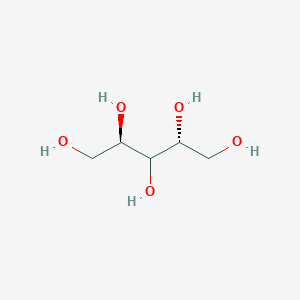| General Information of MET (ID: META00273) |
| Name |
D-Arabitol
|
| Synonyms |
Click to Show/Hide Synonyms of This Metabolite
(+--)-Arabitol; Arabino-pentitol; Arabitol; Arabitol, (D)-isomer; D-(+)-Arabitol; D-Arabinitol; D-Arabinol; D-Arabitol; D-Lyxitol; DL-Arabitol; Lyxitol
|
| Source |
Endogenous;Food;Microbial
|
| Structure Type |
Carbohydrates and carbohydrate conjugates (Click to Show/Hide the Complete Structure Type Hierarchy)
Organic oxygen compounds
Organooxygen compounds
Carbohydrates and carbohydrate conjugates
|
| PubChem CID |
|
| HMDB ID |
|
| Formula |
C5H12O5
|
| Structure |
<iframe style="width: 300px; height: 300px;" frameborder="0" src="https://embed.molview.org/v1/?mode=balls&cid=94154"></iframe>
|
 |
|
3D MOL
|
2D MOL
|
|
Click to Show/Hide the Molecular/Functional Data (External Links/Property/Function) of This Metabolite
|
| KEGG ID |
|
| ChEBI ID |
|
| FooDB ID |
|
| ChemSpider ID |
|
| METLIN ID |
|
| Physicochemical Properties |
Molecular Weight |
152.15 |
Topological Polar Surface Area |
101 |
| XlogP |
-2.5 |
Complexity |
76.1 |
| Heavy Atom Count |
10 |
Rotatable Bond Count |
4 |
| Hydrogen Bond Donor Count |
5 |
Hydrogen Bond Acceptor Count |
5 |
| Function |
D-Arabitol is a polyol. Polyols are sugar alcohols linked to the pentose phosphate pathway (PPP). They are classified on the basis of the number of carbon atoms. Polyols occur in body fluids. A patient with leukoencephalopathy and peripheral neuropathy has been identified as suffering from ribose-5-phosphate isomerase (RPI) deficiency, a defect in the PPP. In this disorder, highly elevated concentrations of the C5 polyols such as D-arabitol are found in body fluids. In addition, transaldolase deficiency, another defect in the PPP, has been diagnosed in a patient with mainly liver problems among others. This patient had increased concentrations of polyols, mainly D-arabitol. So far, the pathophysiological role of polyols is relatively unknown. It is thought that D-arabitol is a metabolic end-product in humans. The strong brain-CSF-plasma gradient of polyols in the patient with RPI deficiency suggested a primary metabolic disorder. The mechanisms of brain and neuronal damage in RPI deficiency remain to be elucidated. A neurotoxic effect due to the accumulation of the polyols may play a role. D-Arabitol is a product of the enzyme D-arabinitol 4-dehydrogenase (EC 1.1.1.11) in the pentose and glucuronate interconversion pathway :1181-3). D-Arabitol has also been found to be a fungal metabolite, urinary D-Arabinitol is a marker for invasive candidiasis or infection by Candida fungal species. It can also a metabolite in Debaryomyces, Pichia and Zygosaccharomyces.
|
|
Regulatory Network
|
|
|
|
|
|
|
|
|
 click to show the details of this protein
click to show the details of this protein
 click to show the details of experiment for validating this pair
click to show the details of experiment for validating this pair

